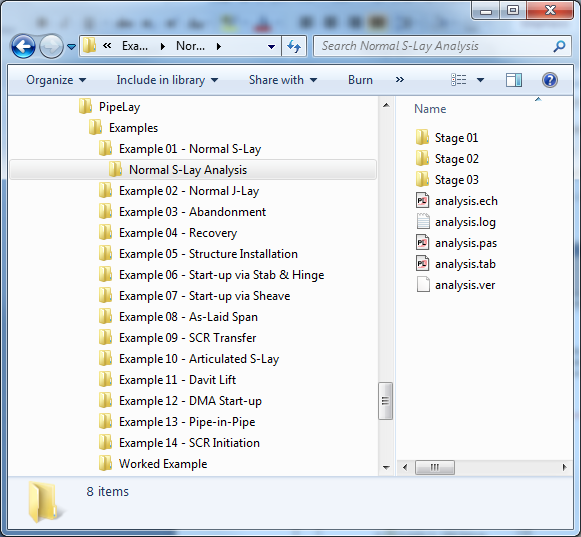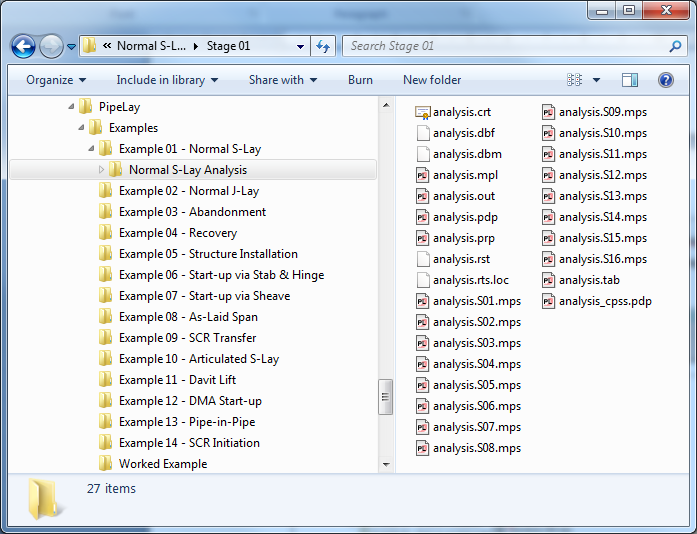The Analysis Results section of the Results tab is divided into two sub-sections. The upper sub-section contains five facilities to enable you to look at results for all stages of the full analysis. These facilities are Open Results Directory, Open Summary Report, Open Summary CSV, Open Custom Reports, Open DNV Report, Open API Report and Open Input Echo. The lower sub-section provides detailed access to the results of a single stage of the analysis.
When you click on Open Results Directory, Windows™ Explorer is launched to allow you to directly access all of the files generated by PipeLay. The results directory is created as a sub-directory of the directory that contains your project file. The results directory is named “<component name>” where <component name> is the name of the Analysis component responsible for generating the results. The figure below shows an example of the results directory for an Analysis component called Normal S-Lay Analysis with three stages.

PipeLay Results Directory (1)
As shown above, the results directory typically contains the following files:
▪analysis.pas Analysis specification file. Input to the analysis engine.
▪analysis.log Analysis log. Run-time output from the analysis engine.
▪analysis.ver Verification file. Run-time output from the analysis engine.
▪analysis.ech Input echo report file. Summary of all user inputs.
Additional files generated by summary postprocessing and DNV/API postprocessing may also be present. The results directory also contains a sub-directory for each analysis stage. The above example shows three sub-directories; Stage 1, Stage 2 and Stage 3.

PipeLay Results Directory (2)
The Stage sub-directories typically include the following files, as shown in the figure above:
▪analysis.crt Criteria iteration summary
▪analysis.dbf Force database
▪analysis.dbm Motion database
▪analysis.mpl Plot file list
▪analysis.out Detailed output file
▪analysis.pdp Dynamic display file
▪analysis.prp Analysis report file
▪analysis.rst Restart file
▪analysis.*.mp* Various plot files
▪analysis.tab Tabular output file (plain text file)
▪analysis.csv Tabular output file (comma separate value file)
▪analysis_cpss.pdp Dynamic display of the cable solution file
Additional files generated by postprocessing may also be present. To open any results file of interest, you double-click on the file.
The Open Summary Report button allows you to view the summary report file (analysis.psr) which is generated by summary postprocessing. This postprocessing feature is discussed further in the Summary Postprocessing Tab article.
Summary postprocessing information is presented in both tabular and graphical format. Like the analysis report file discussed further on, the summary report file is in report-ready format and graphs can be readily copied and pasted into other documents.
The Open Custom Reports button allows you to view the Tabular Report file, which contains the outputs specified on the Tabular Report Tab.
The Open Summary CSV button allows you to view the summary report in a CSV (Comma Separated Values) file called analysis_sum.csv. This file contains the same tabular data as the original summary report file, but it does not contain any of the graphs. Note that this file will open in Windows™ Excel (if available), which in turn offers you a wide range of data processing tools and features.
Note
DNV postprocessing in not available in PipeLay Starter Edition
You use the Open DNV Report button to access the report file generated by DNV postprocessing (analysis_dnv.csv). This file is in CSV (Comma Separated Values) format and so it is viewed using Windows™ Excel, which in turn offers you a wide range of data processing tools and features. The overall operation of DNV postprocessing is described in the Code Checking Tab article, however for now it is worth noting that it performs local buckling unity checks on various sections of a pipeline over any number of installation stages.
The DNV report file itself displays local buckling unity checks both on a node by node basis for each stage as well as on a summary basis where the governing checks are tabulated for all stages.
Note
API postprocessing in not available in PipeLay Starter Edition
You use the Open API Report button to access the report file generated by API postprocessing (analysis_api.csv). This file is in CSV (Comma Separated Values) format and so it is viewed using Windows™ Excel, which in turn offers you a wide range of data processing tools and features. The overall operation of API postprocessing is described in the Code Checking Tab article but in summary, it performs local buckling checks for combined bending and external pressure on various sections of a pipeline over any number of installation stages. The API report file itself displays local buckling unity checks both on a node by node basis for each stage as well as on a summary basis where the governing checks are tabulated for all stages.
The Open Input Echo button opens the input echo report file which is created at generation time when you run a particular analysis. This file contains an echo, or summary, of all input data specified for the various components associated with an analysis. The format of the file is intuitive and corresponds to a set of tables representing the various input dialogs and drop down lists used throughout the PipeLay user interface. The majority of the report is created when you initially run a full analysis and then extra pieces are appended to the bottom of the file when you run subsequent postprocessing type analyses. Note that all pieces, or sections, of the report are time stamped with a suitable header and if a full re-run of the analysis is requested then the input echo is overwritten and recreated from scratch.
The user has the option of disabling the creation of the input echo file by removing the tick mark from the associated box in the ‘Quality Control’ section of the Project component.